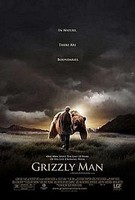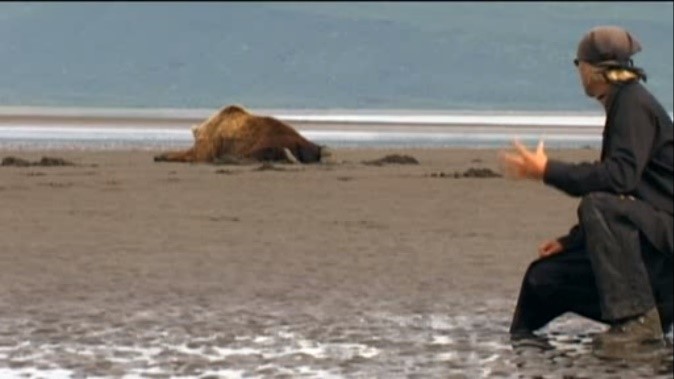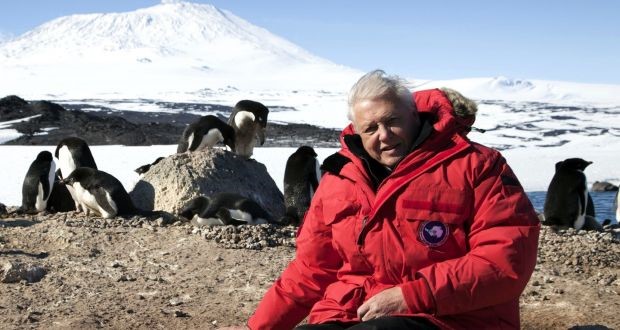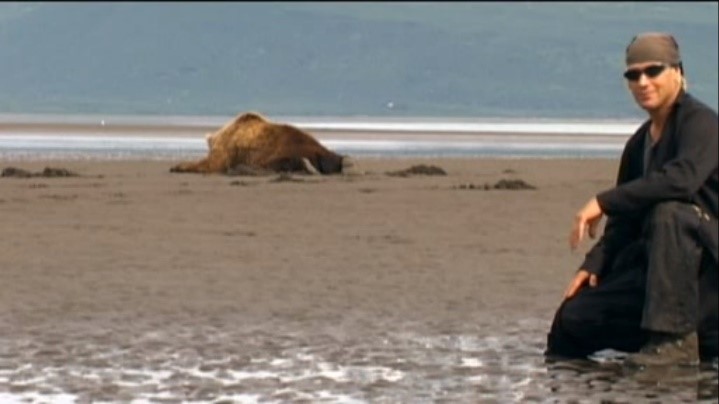
A fascinating aspect about Werner Herzog’s exploration of the life of Timothy Treadwell and his relationships with the wild grizzly bears of Alaska is his investigation of the way Treadwell interpreted the animal world, and the extent to which this reveals aspects to his character. A scene which exemplifies this interpretation is when we’re shown footage that Treadwell shot of a fight between two male bears for the right to court a female grizzly, and the subsequent aftermath of this. What Herzog appears interested in is how Treadwell himself interprets the bear fight through an anthropomorphic perspective, and what this reveals about his own character and relationships with other humans. A significant shot within this section is a ‘conversation’ that Treadwell has with the bear most injured in the fight (who he has nicknamed Mickey).


(Top Left: fig. 1 – Timothy Treadwell talking to ‘Mickey’ the grizzly bear in ‘Grizzly Man’ (2005); Top Right: fig. 2 – David Attenborough with penguins in ‘Life in the Freezer’ (1993))
What’s interesting first off is how this shot framing is interpreted by both Treadwell (as the cameraman) and Herzog (as the director choosing this piece of footage). We can see that Treadwell has set up the shot, with himself in the right foreground and Mickey the bear in the left background, in such a way as to make it appear that they’re almost right next to each other during the talk (see fig. 1). This is a common technique in wildlife filming of making animals appear closer to the narrating subject (see fig. 2). As we are shown over the course of the documentary, Treadwell often took several different shots so that he could choose the best one, so questioning why Herzog (in his role as director/editor) chose this particular shot from the numerous other attempts can reveal the nature of his perspective on this encounter. Despite the way Treadwell set up the shot, the considerable distance between him and Mickey is still apparent – too far for the bear to hear Treadwell’s voice. Moreover, the bear doesn’t appear particularly interested in what Treadwell is saying to him – the bear’s back is to the camera for most of the shot, and even when his head is visible, he is obviously resting it upon the sand whilst napping. This seems to reinforce Herzog’s opinion of the lack of significant connection between humans and animals (despite Treadwell’s attempts to bridge that divide), and the apathy of nature towards humanity.

(Above: fig. 3 – “Things are bad for me with the human women…” Treadwell looks to camera in ‘Grizzly Man’ (2005))
However Herzog also shows Treadwell’s affinity with the bears: he confesses to Mickey that he has had “troubles with the girls”, and although he admits that he wouldn’t be “duking it out for any girl like that”, he concedes “if Saturn [the female grizzly] was a female human, I could just see how beautiful she is as a bear.” Here Treadwell projects his own emotions and desires onto the situation, seeing his own troubled experiences with human relationships reflected in the behaviour of the bears, and seems to empathise more closely with these creatures than with other humans, either despite or because of their apathy towards him.